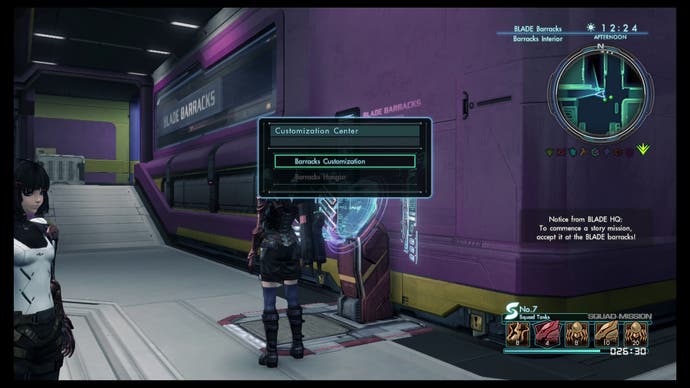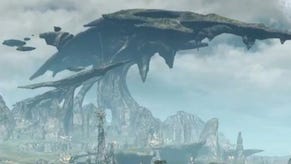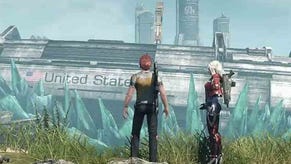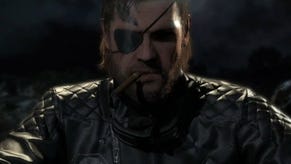Xenoblade Chronicles X review
Mira, Mira on the wall.
Two years ago NASA announced a plan to deliver a container filled with seeds to the moon. It will be the first in a range of experiments to test the viability of humans colonising nearby moons and planets when we're finally done ruining this one. It's a gallant goal and yet, if the seeds do take root and flower, it will take a visionary chef to cook a sustaining meal from the harvest: a fistful of herbs and clutch of turnips. As the world thaws around us, NASA's vision for a lunar garden is something of a beautiful lie, an ecological lullaby sung above deck to soothe souls while our Titanic planet tilts and glugs. Truth be told, if we have to depart terra firma in a hurry, the question of whether we have enough basil to garnish our turnips will be, you might say, of secondary concern.
'A beautiful lie' is exactly how one of Xenoblade Chronicle X's characters describes New Los Angeles, a flat pack city that the last remaining humans managed to fold and load before they fled a devastated Earth. NLA (as you and its other residents refer to it with somewhat forced familiarity) with its aluminium streets, pop-up shops and shrink-wrapped palm trees would be more accurately described as a beautiful distraction. The truth is that Mira, the planet on which you have crash-landed, is entirely alien and mostly hostile. NLA provides both psychic and physical refuge. It's a little oasis of urban familiarity in a vast desert of peril. Resources are dwindling within. Predators are circling without. There's not enough basil to go around. Easier to hunker down in a jack-in-the-box Starbucks and sip a vacuum-packed cappuccino than reckon with the new, horrifying reality of existence.
You, however, are made of sterner stuff. Rather than sit around faking normality you've joined BLADE, a volunteer peacekeeping force committed to scout the planet, hunt for resources, fight off predators and find a way to make Mira feel more like home. The first time you descend the studded ramp leading out of NLA, and head out onto its sun-licked meadows, you realise, happily, this might not be so hard. There are worse places than Mira for a galactic crash-landing. Immediately the elemental panic to survive is overtaken by other emotions.

Wonder, for one. This world is extraordinary, with few rivals to its luxurious diversity in video games. The vigorous plains of Primordia, studded with rocky towers, stratospheric arches and dread caves blend into Noctilum, with its bubbling marshes, purple shrubbery and motorway-thick roots that twizzle up into the clouds. These are just two of five continents, each as wild and distinctive as the last.
This exquisite world stretches high as well as wide. You could be swimming in a lake, only to look up and see a braid of vines splicing the sky a few hundred metres up, as, in the greater distance, Mira's moons dip and lean. A consequence of this verticality is to awake in your explorer mind awareness of a new dimension. Super Mario-esque route finding is rarely found in RPGs. Here, however, you must often survey the horizon or dense foliage, looking for a fat root that might serve as a leader up to higher vegetation, which can then be traversed to find new places and promise.
At a time when most large-scale games don't dare leave players without a stabilising breadcrumb trail that leads to the current objective, Xenoblade Chronicles X feels at once liberating and alarming. You are given giddying route-finding responsibility through Mira's knotted scenery. When you're making progress the design thrills, and becomes a part of the game's ambient challenge. When you become lost, or fail to find a way to your chosen destination, it frustrates - in the same way that all explorers in the past have surely been frustrated.
Then there is the fauna. Mira's wildlife is rich in style and variety, ranging from obnoxious wasps wielding rapier stingers up to prehistoric, four-storey plodders, which lumber in a different time signature. Creatures come in five different size classes, the largest of which you won't be able to take on till much later into your journey, after you've acquired a license to drive a 'Skell', a hulking bipedal tank which, at the squeeze of a button, can transform into an off-road racer, able to tear across the landscape. These beasts can be fought in complicated ways, as you target, say, their tails, hoping to score a rare item drop when the appendage falls. Not everything is out to get you. Some animals will attack on sight, others on sound (creatures spoiling for a fight are clearly marked, so you can avoid them if you so choose). Most, however, will leave you well alone until provoked.

You are accompanied by up to three other characters, either computer-controlled NPCs, AI-controlled characters 'scouted' from other players' games (who earn rewards for their creator while in your game) or, much later, other players who may accompany you live across the internet. The game's structure is closest to an MMO, although the precise recipe is singular and unfamiliar. Aside from the battle system, this is a very different game to its predecessor.
Mira's map, constantly and essentially displayed on the Wii U's second screen, is divided into a honeycomb grid of hexagons. Discover new tiles and, in many cases, you'll create a shortcut, enabling you to zip around the world to complete missions with a stab of the controller's screen.
The Wii U controller is used in a vital, integral manner. Each hexagon contains its own challenge: a location where you're able to place a resource-gathering mine shaft (needed to harvest fuel for your Skell), for example, or a 'tyrant' one of the game's named boss creatures, which drop unique items. As you complete the various tasks in these hexagons, you colour the map with information, quantifying the explorer's journey in pleasing ways.
The formal story delights too. There are only 12 core missions, but each of these has various involved criteria to clear before they become accessible. Almost all other missions can be undertaken synchronously, so, as the game evolves, every excursion into Mira sees you advancing your progress across multiple axes. Thematically, director Tetsuya Takahashi uses the game to explore some interesting terrain, particularly in the friction that develops as friendly alien races learn to live and work with one another. The writing is straightforward but, at times, affecting, especially in some of the optional quests where, for example, you must help guide a xenophobic human on their journey from ignorance to acceptance.

Takahashi has no qualms about delaying gratification. You'll need to work your way through many hours of exploration before you're permitted to take a license test to drive one of humanity's few precious Skells. When you eventually get there, there are various further hoops through which you must jump. Few other blockbuster game developers in the world would have the gumption to hold such a crucial, desirable tool back for so long. When you're given your first Skell, allowed to customise its colour scheme, kit it out as you see fit and, finally, drive off to settle an old score with one of Mira's giant monsters, the sense of accomplishment is delicious.
At times the design team struggle to keep up with their energetic creative ambition, failing to elegantly lead you through some of its secondary and tertiary systems. For example, you have the chance to lay a network of mining probes in key sites in Mira. These probes come in various guises, each with various effects, and are further affected by their neighbouring probes.
Optimising your network takes time, and the design team offer little assistance. Many of the story missions are only unlocked when you complete so-called affinity missions, which strengthen the links between specific characters. There are often no clues as to the starting location of these prerequisite missions and some don't become available till you've first met other opaque criteria. Some will relish all of these Dark Souls-esque arcana. Many will baulk at the game's stringent demands.
Nevertheless, this is contemporary Japanese RPG-making at its boldest and most imaginative in years. For every cliché - the helium-voiced furry mascot who totters along behind your group, the incongruous, schizophrenic rock-cum-rap soundtrack - there's an invention that hauls the open-world JRPG into the present, and then another that shunts it breezily into the future. Perhaps the game's greatest achievement is that, over the course of this journey, you settle into Mira and, in that mystical way of all video game greats, Mira settles into you.










